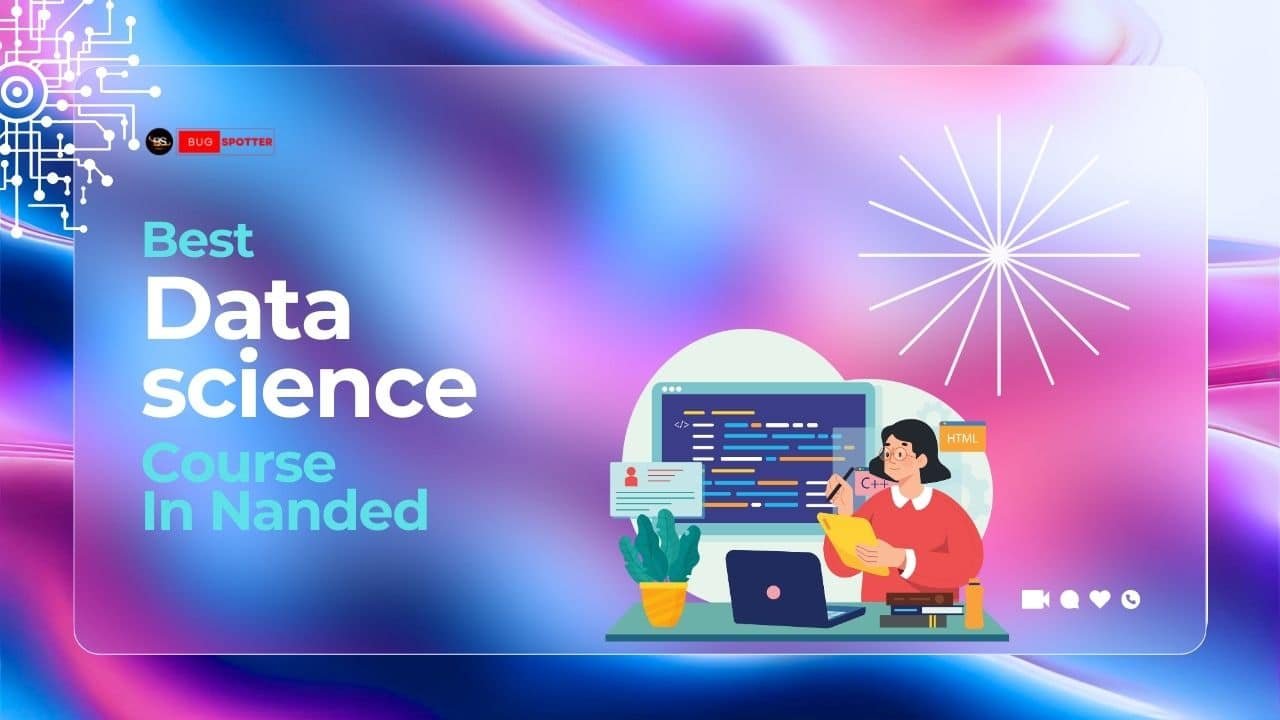Best Data Science Course In Nanded With Placement
100% Placement Assistance | Live Online Sessions
Data Science course : 4 Month Personalized Live Advance Data Science Training is taught by industry experts in a comprehensive & question-oriented format.
Enroll Before: 07 December, 2024
1000+
Students Trained
100%
Placement Assistance
07 December, 2024
Start Date
0%
EMI Available
7:30 AM - 9:30 AM
Lecture Timings ( IST )
Key Highlights Of The Advance Data Science Course
- 100+ Hours Of Live Class
- 50+ Hours of Videos
- 1-on-1 Mentoring Sessions
- 20+ Industry Tools Mastery
- In-Class Live Presentations
- 3+ Live Projects & Practice Assignments
- 100% Placement Assistance
- Resume & Interview Training
Get familiar with our online Python Data Science course syllabus.
Syllabus for Data Science Course
Online Advance Data Science Course in Pune is designed to teach students the basics to the advanced level concepts of Python Data Science with practice assignments and offline in-class projects which helps them to get placed in MNC’s.
Term 1
In this term, you will learn how to ace Python Basics, Python OOPS and Python Libraries like Pandas, Matplotlib, Numpy, etc…
Python Basics :
- Why python
- Python IDE
- Basics of programming
- Variables , Data Types
- Conditional statements
- Loops
- Logical Thinking
- Data Structures
- Functions and types of arguments
- Lambda Functions
- memory Management
- garbage collector
- Copies - shallow copy, deep copy
- Higher Order Functions - Map , Reduce , Filter
- Iterable , Iterator , generator
- Exception handling
- Programming interview questions
Python OOPS :
- Class
- constructor and its types , Destructor
- Types of variables - instance , static
- Inheritance - Single , Multiple , Multilevel , Hierarchical
- polymorphism
- duck typing
- Overloading - method , Operator , constructor
- overriding - method , Constructor
- Super Function
- Encapsulation
- access Modifiers
- Abstraction
- monkey patching
Pandas :
- Introduction to Pandas
Series Data Structure - Data Frame Data Structure
- Merging DataFrame
- Read Complex CSV , JSON , excel Files using pandas
- Write to File
- Data Frame Manipulation - head , Tail , Describe , shape ,Drop , inplace
- loc & I=iloc
- Apply Function
- Value count
- Add Column
- Add Row To DataFrame - using concat,Append
- Order By Operation
- Sort Values
- Group by operation
- Pivot Table
- Date/ Time Functionality
- Example Manipulating DataFrame
Matplotlib :
- line graph
- bar Plot
- scatter plot
- pie chart
- other function
Numpy :
- Introduction to Numpy
- Creating Arrays , Indexing , Slicing
- Data Types
- Copy vs View
- Array Shape & Reshape
- Arrays Split & Joins
- Arrays Filter
- Seaborn Model
Data Engineering in Python :
- Handling Missing Data
- Techniques to inpute missing Values
- Meaningful Data transformation
- Encoding Data
Data Visualization in Python - Read Json , CSV's, excels
Term 2
In this term, you will learn how to ace MySQL, AWS, Tools & IDE’S
MYSQL :
- DBMS & RDBMS
- Data Types
- DQL
- DDL
- DML
- TCL
- DCL
- Key Constraints
- Operators
- Clouses
- Aggregate Functions
- Indexes
- Views
- Triggers
- JOINS
- Sub Queries & Nested Queries
- Use of AWS
- Cloud computing models
- S3
- AWS Data Pipeline
- EMR
- AWS Glue
- Athena
- Redshift
Azure devops :
- Use Of Devops
- CI/ CD Pipeline
- work item
- sprints
- repository
- state of task
- Repose Clone
- pull request
Git :
- Use of Git
- feature branch
- clone
- Add
- Commit
- Push
IDE :
- PowerBI :
- Dashboards
- Application
- DBeaver :
- Connection Process
- DB Manipulation
- Jupyter Notebook :
- Google Colaboratory
- Pycharm
Term 3
In this term, you will learn how to ace Framework and industry projects
Pyspark :
- Use of Pyspark For Data Science
- Spark Session & RDD
- Timestamp
- Schema
- Parallelize
- Broadcast Variable
- Create DataFrame
- Transformations & actions
- Empty DataFrame
- Structure type and structure field
- Select
- Collect
- WithColumn
- Where & Filter
- Drop & Drop Duplicate
- orderby and sortby
- Groupby
- Joins
- union and union all
- union byname
- map , flatmap
- Sample by vs Sample
- Pivote
- maptype
- Aggregate Functions
- Windows Function
- Read and Write in CSV
- When
- Split
- collect
- Row number
- dense rank
1) E-Commerce
2) Banking Domain

The Career Opportunities After Completing a Data Science Course in Nanded
Data Engineer: Building and maintaining data pipelines, and working with data storage solutions and tools such as AWS Glue, Redshift, and MySQL.
Quantitative Analyst: Applying quantitative techniques to financial and business data, leveraging Python for data manipulation and analysis.
Data Analyst: Performing data analysis and visualization using tools like Pandas, Matplotlib, and PowerBI, and creating actionable insights from data.
Cloud Data Engineer: Working with cloud services and data pipelines, including AWS services like S3, EMR, and Athena.
DevOps Engineer: Implementing CI/CD pipelines and managing version control with Git, focusing on automation and integration in data engineering projects.
Tools You’ll Master










Data Science course fees
Unlock your potential with Bug Spotter Software Training Institute’s Data Science course for just 30,000 Rs! Dive into an exciting journey where you’ll master Python, machine learning, data visualization, and big data tools. This comprehensive program offers hands-on training, real-world projects, and expert guidance to help you become a sought-after data science professional. Plus, enjoy career support with resume building and job placement assistance. Don’t miss the opportunity to transform your career and step into the future of technology with this affordable, high-quality course!
Mentors

Python Trainer
4+ Years ITExperience
4+ Years Teaching Experience

Project Trainer
5+ Years IT Experience
5+Teaching Experience

Digital Marketing
3+ Years IT Experience
2+Teaching Experience

Manual Trainer
5+ Years IT Experience
5+Teaching Experience
Our Learners Work At

























Enroll Now and get 5% Off On Course Fees
Bug Spotter Reviews
Introduction to Data Science
Data science is the process of using data to uncover patterns and insights that solve real-world problems. It helps businesses make informed decisions by analyzing large datasets, turning them into actionable knowledge.
Why Data Science Matters
Data is all around us—from online shopping to social media. Data science transforms this raw data into insights, helping businesses improve products, predict trends, and make smarter decisions.
Key Components of Data Science
- Data Collection: Gathering data from various sources (surveys, social media, sensors).
- Data Cleaning: Fixing errors and organizing data for analysis.
- Data Analysis: Finding patterns and insights in the cleaned data.
The Data Science Process
- Collect data
- Clean data
- Analyze data
- Build models
- Interpret findings
Data Science Projects
Projects start with a business problem (e.g., predicting sales), followed by data collection, analysis, and presenting findings to guide decisions.
The Role of a Data Scientist
Data scientists gather, clean, analyze data, and build models to solve problems. They work with business leaders to turn data into actionable insights.
Applications of Data Science
- Healthcare: Predict disease outbreaks, improve patient care.
- E-commerce: Recommend products, improve customer experiences.
- Finance: Detect fraud, manage risks, predict market trends.
How to Get Started in Data Science
- Courses: Take beginner-friendly courses online (e.g., Coursera, edX).
- Practice: Work on projects using real-world datasets to build your skills.

Eligibility
for Data Science Course
1. Any Graduate Background
You can come from any field—engineering, commerce, humanities, or anything else. As long as you have a degree, you’re eligible to join the course.
2. Interest in Coding
You don’t need prior coding experience, but having an interest in learning programming will help. You’ll learn languages like Python, R, and SQL during the course, and don’t worry if you’re new to coding—these skills can be picked up along the way!
3. Time Commitment
You’ll need to dedicate at least 3-4 hours a day to the course, including time for lectures, assignments, and hands-on practice. Consistency is key to making progress and mastering the material.
4. No Prior Experience Required
No previous experience in data science is needed. The course starts with basic concepts and gradually moves to more advanced topics, so even if you’re a complete beginner, you can succeed.
5. Curiosity & Problem-Solving Mindset
If you enjoy exploring new things and solving problems, you’re in the right place. Data Science is all about using data to find solutions to real-world challenges, and a curious, problem-solving attitude will help you thrive.
FAQs
Frequently asked questions
1. What is Data Science, and why is it important?
Data Science is the field that involves analyzing large amounts of data to find patterns, insights, and trends that can guide decision-making. It plays a crucial role in industries like healthcare, finance, and e-commerce, where data-driven decisions can improve efficiency and drive growth.
2. Who can benefit from learning Data Science?
Anyone, regardless of background, can benefit from learning Data Science. While a foundation in mathematics or programming can be helpful, there are courses available for absolute beginners as well. Anyone interested in solving problems with data can pursue this field.
3. What tools and technologies will I learn in a Data Science course?
In a Data Science course, you’ll learn how to use programming languages like Python and R, tools for data visualization like Tableau and Matplotlib, as well as how to clean and organize data. Some courses also cover machine learning, artificial intelligence, and working with big data tools.
4. How long do Data Science courses usually take?
The length of Data Science courses can vary. Short, introductory courses might last a few weeks, while more in-depth certifications or diplomas can take several months or even a year to complete, depending on the pace and depth of the program.
5. Can a beginner handle a Data Science course?
Yes! Many Data Science courses are designed with beginners in mind, starting with foundational concepts and gradually progressing to more advanced topics. As long as you are committed and practice regularly, you can succeed in learning Data Science.
6. What jobs can I get with a Data Science qualification?
After completing a Data Science course, you can pursue roles such as Data Scientist, Data Analyst, Machine Learning Engineer, Data Engineer, or Business Intelligence Analyst. These roles are in high demand across many sectors like technology, healthcare, finance, and marketing.
7. Do I need prior experience in programming or mathematics for a Data Science course?
It depends on the course. Some courses require basic knowledge of mathematics and programming, while others are beginner-friendly and start from scratch. It’s a good idea to check the course prerequisites before enrolling to ensure you’re prepared.
8. Will I learn about Artificial Intelligence or Machine Learning?
Yes, most Data Science courses include machine learning as part of the curriculum. Machine learning is an essential aspect of data science that helps build models to predict outcomes and uncover hidden patterns in data.
9. What is the difference between Data Science and Data Analytics?
While both fields work with data, Data Science covers a broader range of topics, including machine learning, data modeling, and predictive analytics. Data Analytics, on the other hand, focuses primarily on interpreting and analyzing existing data to gain insights for decision-making.
10. Are online Data Science courses a good option?
Yes, online courses are a great way to learn Data Science. Many reputable platforms offer flexible, self-paced learning options, allowing you to study according to your schedule. Online courses often provide a range of materials, including video lectures, readings, and hands-on projects.
Data Engineer
Roles and Responsibility for Data Engineer
Roles and Responsibility for Data Engineer
The key responsibilities of a data engineer typically include:
- Designing and building robust, scalable and reliable data pipelines to ingest, transform and load data from various sources.
- Implementing efficient data storage solutions, such as data warehouses, data lakes or NoSQL databases, to support reporting, analytics and business intelligence needs.
- Developing data transformation logic to clean, enrich and normalize data to ensure high-quality information.
- Collaborating with data analysts and business stakeholders to understand data requirements and design appropriate data models.
- Ensuring data quality, security and compliance through monitoring, alerting and continuous improvement processes.
- Deploying and maintaining data engineering solutions, including pipelines, data stores and supporting infrastructure.
- Sharing knowledge, best practices and lessons learned with the broader data engineering community.
Course Duration
Data Science in 3 Months?
Can I Learn Data Science in 3 Months?
Yes, it’s possible to learn Data Science in 3 months with dedication and consistency. To achieve this, you’ll need to commit at least 3-4 hours per day, focusing not only on lectures but also on hands-on practice, solving problems, and applying concepts to real-world projects. Regular practice is essential, especially in areas like Machine Learning, Data Analysis, and Data Visualization.
In addition, working on multiple projects is crucial to reinforce your learning and build a strong portfolio. This practical experience will make you more competitive when applying for jobs.
While staying focused and following a structured plan, you can gain a solid understanding of Data Science and develop a portfolio of projects in just 3 months, positioning yourself for job opportunities in the field.


